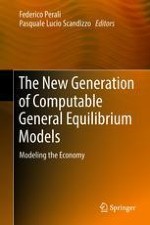
2018 | OriginalPaper | Chapter
General Equilibrium Modelling: The Integration of Policy and Project Analysis
Authors : Federico Perali, Pasquale Lucio Scandizzo
Published in: The New Generation of Computable General Equilibrium Models
Publisher: Springer International Publishing
Activate our intelligent search to find suitable subject content or patents.
Select sections of text to find matching patents with Artificial Intelligence. powered by
Select sections of text to find additional relevant content using AI-assisted search. powered by